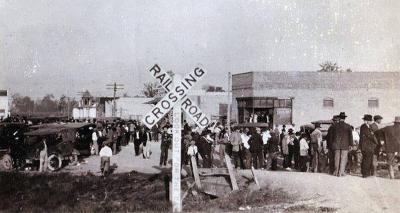The Elaine, Arkansas, Story

Image courtesy of The Elaine Legacy Center
A crowd of white people gathers outside a building in Elaine, Arkansas, in 1919. This building was the center of the mob violence in the 1919 Elaine Massacre. It is thought to be the oldest structure remaining in Elaine.
The Elaine Massacre, perpetrated in and around Elaine, Arkansas, in 1919, was one of the bloodiest racial attacks on Blacks in the U.S. Like the massacre in Tulsa, Oklahoma in 1921 there is no accurate data on exactly how many people were killed. However, estimates of between 200 and 300 are the same for both massacres.
Beginning on September 30, and continuing through October 2, 1919, more than 200 Black men, women, and children were slaughtered. The massacre was perpetrated by white people and U.S. soldiers in reaction to Black landowners and sharecroppers who organized to try to get fairer prices for their crops,
In the wake of the onslaught, Blacks lost ownership of their farms and businesses. Immediately, a white and state-led campaign of lies and cover-up was created. One component of the white narrative was to maintain that the area surrounding the town was all owned by white people who either farmed the land or contracted with Black sharecroppers. From the beginning, the white narrative has been that local whites assisted by federal troops had done nothing wrong. They were only restoring order in a town with rebellious Blacks. Just like Tulsa two years later, no white person was convicted or charged with a crime.
The descendants and current residents of Elaine have continued to suffer from unjust treatment. In recent years they have experienced the white leadership of the school district take away their school, so their children must take a long bus ride to school. The farms that surround the community have adopted farming practices that result in poisoning the water, spraying poisonous chemicals from an airplane, and burning fields after the harvest. All this has impacted the health of the current residents.
Today, there is an opportunity to develop a program of reparations led by the descendants of those who had their land stolen, businesses destroyed, and community dispersed. It would be difficult to find a situation where there is a greater need for reparations.
Under the leadership of the descendants of people who were living in Elaine in 1919 a realistic plan can be prepared and executed. Among other things, it can rebuild the community that existed in 1919 where there are businesses owned by people of color and jobs that pay a living wage, where children receive a quality education at a school they can walk to and there are resources for them to pursue their dreams, and where the community is surrounded by an agricultural community that offers opportunities for minority farmers and no longer poisons the air, water, and soil. A program might also include the development of anti-racism tourism where people from around the country can come to Elaine to not only learn Elaine’s history but also discover how a community can be restored to health with an intentional program of reparations and restitution.
It was recently documented that TIAA owns thousands of acres of land surrounding Elaine that were stolen in 1919. TIAA is a company that was founded in 1918 with a commitment to provide educators with financial resources for their retirement. They continue to promise their customers that they are not just making money for them, but also making the world a better place. This is an opportunity for TIAA to put into practice its company values by providing leadership to corporate America with the restoration of the Elaine community and reparations to descendants of the 1919 massacre.
